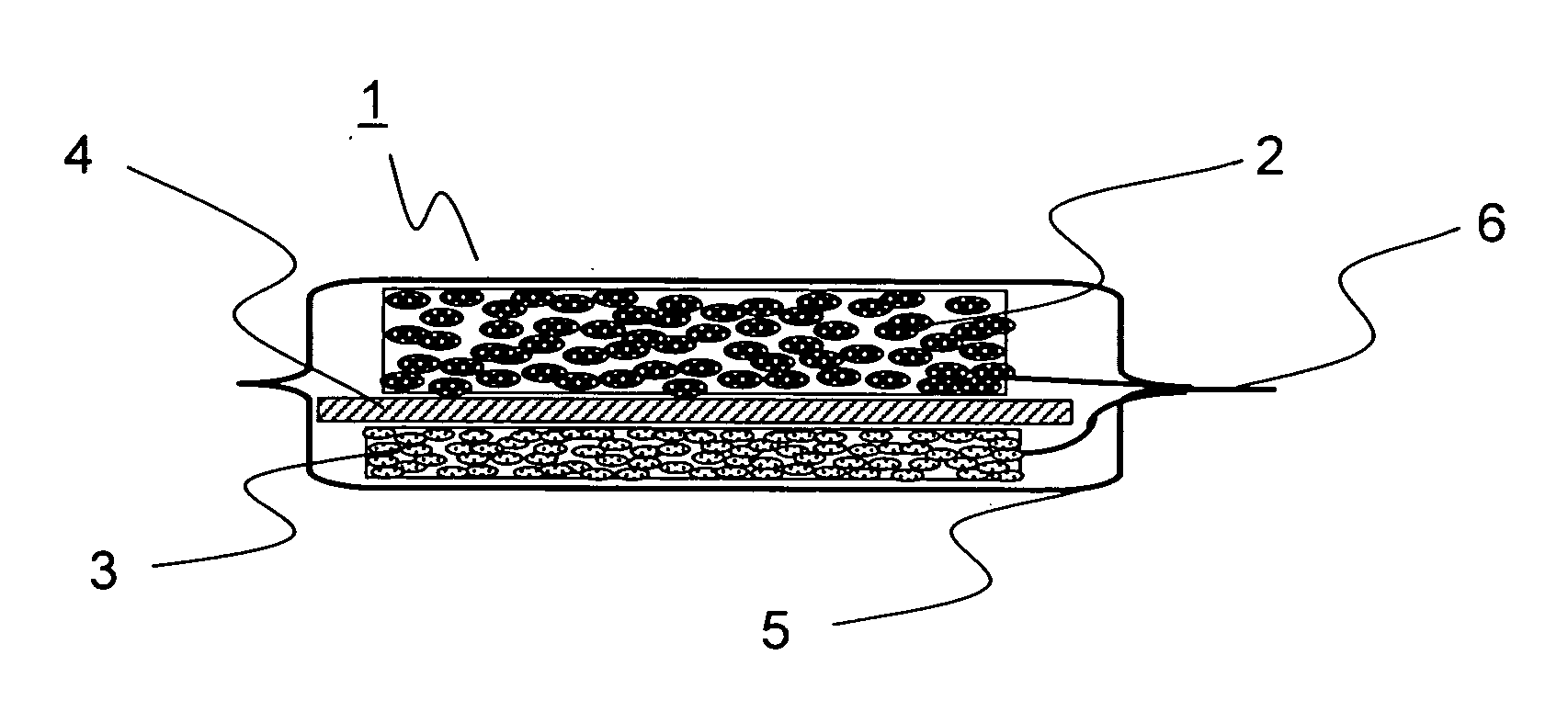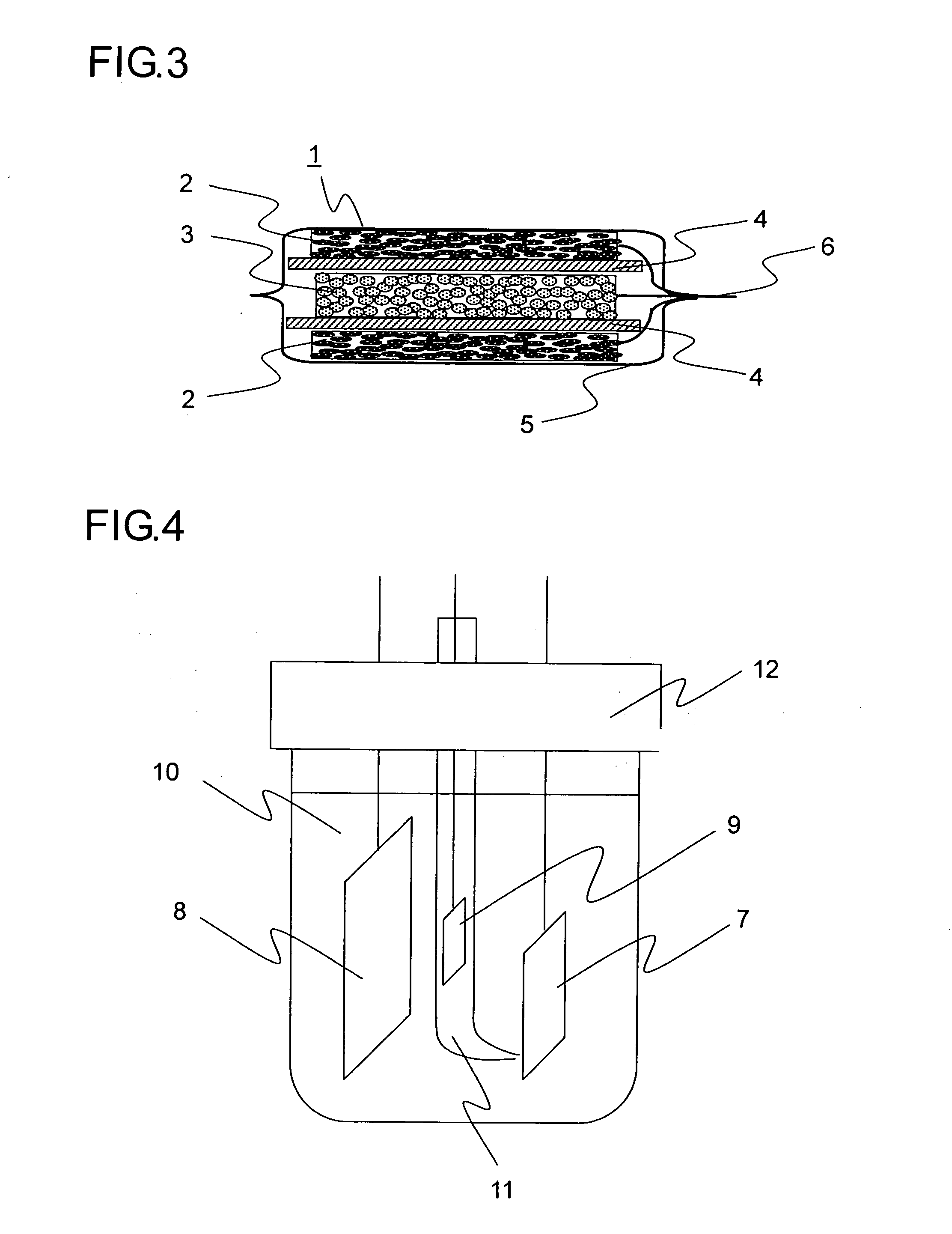Lithium-ion secondary battery and manufacturing method thereof
a secondary battery and lithium-ion technology, applied in the direction of cell components, final product manufacturing, sustainable manufacturing/processing, etc., can solve the problems of reduced manufacturing efficiency, complicated manufacturing procedures, and insufficient satisfaction of users' demands of lithium-ion secondary batteries, and achieve low cost, good high-current discharge performance, and simple procedure
- Summary
- Abstract
- Description
- Claims
- Application Information
AI Technical Summary
Benefits of technology
Problems solved by technology
Method used
Image
Examples
example 1
[0094] In Example 1, 20 grams of natural graphite powder from China (scaly particles having a size of 11 μm, d002 of 0.336 nm, Lc of 100 nm, La of 100 nm, an R value of 0, and a specific surface area of 8 m2 / g), 1 gram of coal pitch (flaky particles having a size 15 μm), 1 gram of carboxymethylcellulose, and 5 grams of VGCF (fibrous powder having a particle size of 5 μm) were mixed in a mortar, and then 40 mL of ion exchange water was added thereto so as to obtain a paste. The paste thus obtained was rubbed into a nickel foam plate (30×30 mm in area, 1 mm in thickness, a porosity of 90%, and a maximum pore diameter of 0.5 mm). The resulting plate was then temporarily dried in an atmosphere with a temperature of 60° C., and was then sintered in a nitrogen atmosphere at 1000° C. for 5 hours, and then a nickel lead wire was spot-welded thereto so as to obtain a carbon electrode for a lithium-ion secondary battery. Suppose that the charge / discharge capacity per unit weight of carbon is ...
example 2
[0095] In Example 2, 20 grams of artificial graphite powder (flaky particles having a size of 18 μm, d002 of 0.337 nm, Lc of 80 nm, La of 80 nm, an R value of 0, and a specific surface area of 12 m2 / g), 1 gram of petroleum pitch (flaky particles having a size of 12 μm), 1 gram of carboxymethylcellulose, and 5 grams of copper fiber (fibrous powder having a particle size of 5 μm) were mixed in a mortar, and then 40 mL of ion exchange water was added thereto so as to obtain a paste. The paste thus obtained was rubbed into a SUS304 plate with a lath structure (30×30 mm in area, 1 mm in thickness, a porosity of 90%, and a maximum pore diameter of 0.5 mm). The resulting plate was then temporarily dried in an atmosphere with a temperature of 60° C., and was then sintered in a nitrogen atmosphere at 600° C. for 5 hours, and then a nickel lead wire was spot-welded thereto so as to obtain a carbon electrode for a lithium-ion secondary battery. Suppose that the charge / discharge capacity per un...
example 3
[0096] In Example 3, 20 grams of natural graphite powder from Madagascar (scaly particles having a size of 12 μm, d002 of 0.336 nm, Lc of 100 nm, La of 100 nm, an R value of 0, and a specific surface area of 7 m2 / g), 1 gram of coal pitch (flaky particles having a size of 15 μm), 1 gram of carboxymethylcellulose, and 5 grams of polyester fiber (fibrous powder having a particle size of 8 μm) were mixed in a mortar, and then 40 mL of ion exchange water was added thereto so as to obtain a paste. The paste thus obtained was rubbed into a nickel foam plate (30×30 mm in area, 1 mm in thickness, a porosity of 90%, and a maximum pore diameter of 0.5 mm). The resulting plate was then temporarily dried in an atmosphere with a temperature of 60° C., and was then sintered in a nitrogen atmosphere at 1000° C. for 5 hours, and then a nickel lead wire was spot-welded thereto so as to obtain a carbon electrode for a lithium-ion secondary battery. Suppose that the charge / discharge capacity per unit w...
PUM
| Property | Measurement | Unit |
|---|---|---|
| battery capacity | aaaaa | aaaaa |
| electrical resistivity | aaaaa | aaaaa |
| electrical resistivity | aaaaa | aaaaa |
Abstract
Description
Claims
Application Information
 Login to View More
Login to View More - R&D
- Intellectual Property
- Life Sciences
- Materials
- Tech Scout
- Unparalleled Data Quality
- Higher Quality Content
- 60% Fewer Hallucinations
Browse by: Latest US Patents, China's latest patents, Technical Efficacy Thesaurus, Application Domain, Technology Topic, Popular Technical Reports.
© 2025 PatSnap. All rights reserved.Legal|Privacy policy|Modern Slavery Act Transparency Statement|Sitemap|About US| Contact US: help@patsnap.com



